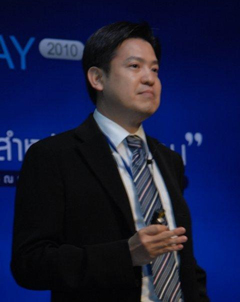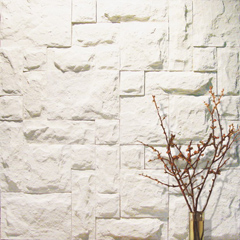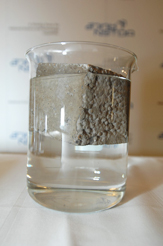The light-weight synthetic pellet “G-Rock”, an innovation for construction materials developed by MTEC researchers, was voted the “Most Interesting Technology for Investment” by investors at the NSTDA Investor’s Day 2010 event. The innovation adds value to sedimentary clay from tap water plants, adds weight-bearing and insulation
properties to and reduces the weight of regular concrete as well as protecting the environment as it circumvents the need to use stone meal resulting from setting explosions to limestone mountains.

- “G-Rock”, lightweight pellets synthesized from sedimentary clay from tap water plants and used for reinforcing lightweight concrete were voted the “Most Interesting Technology for Investment”.
- There are no restrictions as to business collaborations. It depends on the manner in which business operators apply this technology.

Dr. Pitak Laoratanakul, a researcher working at the Ceramics Technology Research Laboratory of the National Metal and Materials Technology Center (MTEC), revealed that, “Recently, light-weight concrete products were used in place of regular concrete as they provided good insulation against outside heat. However, the problems of weight bearing and high humidity absorption posed some restrictions to the application of these products. MTEC’s Ceramics Technology Research Laboratory realized this and saw the chance to make synthetic light-weight pellets from sedimentary clay left as waste from tap water plants that could be mixed with regular concrete. They help increase insulation capacity and reduce overall weight by 20-30% while maintaining the strength of regular concrete. Their physical characteristics can be further enhanced in various manners, depending on the demands of each work.”
The light-weight synthetic pellet “G-Rock” was unveiled on NSTDA Investor’s Day and attracted wide attention from investors and industrial business operators that wished to use this product for commercial purposes. With the construction industry being large and having various needs, our construction materials industry largely depends on imported technologies, especially in the case of materials with high insulation and light weight. However, these technologies are sometimes not suitable to our climate or not able to meet the needs of local applications. Thus new material innovations made by Thai researchers are needed by this industry.

“The fact that the “G-Rock” was able to solve the problems of regular concrete as well as the fact that the research team was able to use the “G-Rock” to meet various needs of different clients were among the reasons why the “G-Rock” was voted the Most Interesting Technology for Investment,” added Dr Laoratanakul.
“Currently, we don’t have restrictions as to the format of collaborations with the private sector. It depends on the application of the technology. For example, an investor who doesn’t have experience in using technologies for commercial purposes might form a joint venture with the NSTDA, while an investor from a related industry such as the concrete industry who has basic knowledge in this matter might need collaboration with the agency in the form of technology transfer,” added Dr Laoratanakul in regard to collaboration.
Dr. Laoratanakul concluded that, “Even though some technologies presented on NSTDA Investor’s Day were not successful in securing commercial collaboration, the researchers still had the chance to exchange their views with investors or business operators in related industries, who were able to criticize the researchers’ work. They might have received suggestions from some other industries which did not appear to relate to their research, thus allowing them to further their research to offer a wider range of applications.”
NSTDA Investor’s Day was held for the first time on 16th September 2010 under the title “Businesses, Technologies, Good Things for Investors” to connect the industrial, investment and financial circles to the scientific fields, promoting investment in technologies that would clearly create economic and social benefits. Five exceptional research projects were presented at the event, allowing investors to choose one as the most interesting technology for investment. Another 25 interesting research projects were also presented under three themes: Better Food, Better Living and Better Energy.
For more information, please contact:
Tecnology Licensing Office
National Science and Technology Development Agency (NSTDA)
Tel: 0 2564 7000 ext 1628-1629
Fax: 02-5647003
e-mail: This email address is being protected from spambots. You need JavaScript enabled to view it.
